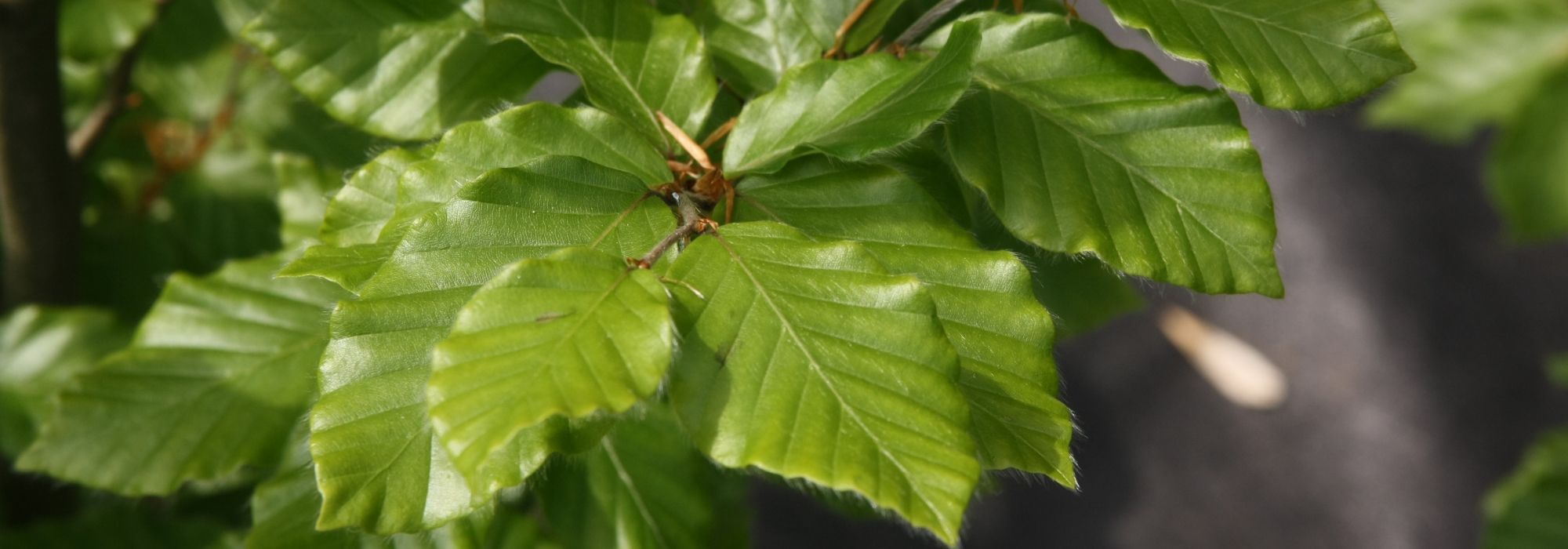
Beech, Fagus : planting, pruning and care
Contents
Beech in a nutshell
- Beech is a well-known native essential oil of our forests
- Very hardy, it resists frost and is not too demanding regarding soil, provided it is well drained
- This tree is grown either in full sun or partial shade depending on foliage colour
- Because of its growth, beech should be grown as a solitary specimen in large gardens or parks
- But its remarkable resistance to severe pruning makes it a good choice for formal hedges
A word from our expert
Well-known tree of forests of Western Europe, common beech or fayard is a handsome tree with a vertical trunk that populates what ecologists call beechwoods. There are about ten species of the genus Fagus, all distributed across Northern Hemisphere in temperate zones. Its marcescent foliage is somewhat reminiscent of hornbeam, but leaves are villous rather than dentate.
Despite its size, it can quite easily be introduced into a garden as a solitary specimen by choosing less bulky varieties or, more simply, by using it as a clipped hedge thanks to its incredible resistance to pruning. It is also one of most beautiful deciduous species for trying one’s hand at bonsai.
It is a tree that withstands the most intense cold in winter. Unfortunately, a contrario, heat and drought do not suit it. Cultivation in southern France is therefore out of the question. Moreover, recent climate changes are gradually causing it to shift northwards in Europe at expense of another well-known tree: oak.
Beeches thrive in all well-drained, fairly fertile soils, but sheltered from strong winds, because their root system is relatively small compared with their size.
Description and botany
Botanical data
- Latin name Fagus sp., Fagus sylvatica
- Family Fagaceae
- Common name Beech, Fayard, Fayaud, Fouteau, Fau, Favinier...
- Flowering April–May
- Height 1.5 m to 10 m or more
- Exposure sun, partial shade and shade
- Soil type all types of humus-bearing soil and well drained
- Hardiness -20°C
Beeches or Fagus belong to family Fagaceae. The genus includes around ten species distributed across Northern Hemisphere, including Fagus domestica, widely used for hedging, and Fagus sylvatica, the common beech that naturally populates our forests, forming what ecologists call a beechwood.
Beeches are large trees that can grow to over 40 m tall with a straight trunk and a rather conical habit in youth, gradually rounding with time. Various cultivars are now available to suit different tastes and gardens: dwarf forms, columnar or fastigiate types, weeping forms, purple-leaved varieties…
Bark is smooth and light grey. Trunk remains straight and lower branches grow horizontally. Young twigs bear large pointed buds.
Foliage is deciduous and only appears around May. This peculiarity leaves enough light in spring for woodland perennials and bulbous plants to flower before a leaf canopy forms: such plants are described as vernal. Beech leaves are ovate, undulate and glossy. They are arranged alternately on the shoots and are petiolate. Leaves are green in season then turn yellow to coppery in autumn. Some varieties have golden, purple or variegated foliage. Leaves measure about 7 cm long by 4 cm wide. They could be mistaken for hornbeam leaves if one did not recall an old mnemonic: “le charme d’Adam est d’être à poil”. This helps remember that hornbeam leaves are dentate while beech leaves are villous on the margins.
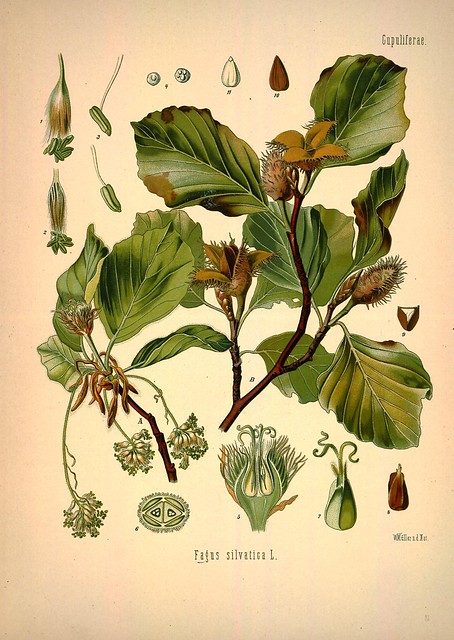
Fagus sylvatica – botanical illustration
Leaves are marcescent: this means that once dead they remain on the tree and only fall definitively when new foliage appears in spring. This is particularly useful when using beech for a hedge. Bear in mind, however, that in exposed windy sites the dead leaves may still drop in winter.
Beeches are monoecious, meaning male and female flowers occur on the same tree. Beech flowers from April to May, but this flowering has little aesthetic interest and does not attract many insects.
However, once female flowers are fertilised, a fruit develops. It takes the form of a capsule covered with soft, curved spines that open at ripeness, revealing 2 to 4 small shiny brown tetrahedral fruits called beech-nuts. The seed is contained within these beech-nuts. Although enjoyed by children and walkers, the fruits are toxic in large quantities, but are seldom eaten in great amounts… They are, however, much appreciated by woodland fauna: mammals and birds which disperse them and thus perpetuate the species.
Growth is relatively slow, especially in the first years. But beeches can live for a very long time: at least a few centuries. Sexual ripeness, i.e. flowering and fruiting, only occurs at around forty years of age.
Beeches tolerate cold down to −20 °C, yet the hot, dry summers experienced in recent years in our regions tend to push beech northwards in favour of oaks. Pure beechwoods are thus gradually transforming into beech-oak woodlands and, in the long term, may revert to almost pure oak woods as occurred two thousand years ago.

Fagus sylvatica: pointed buds, young foliage, female aments, fruits containing the seeds and superb autumn foliage
Our favourite varieties
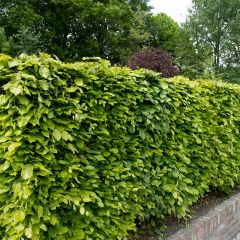
Fagus sylvatica - Beech
- Flowering time May, June
- Height at maturity 20 m
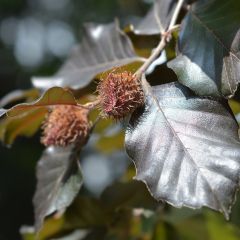
Fagus sylvatica Atropurpurea - Beech
- Flowering time May, June
- Height at maturity 20 m
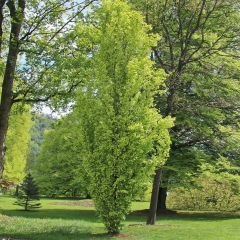
Fagus sylvatica Dawyck Gold - Beech
- Flowering time May, June
- Height at maturity 20 m
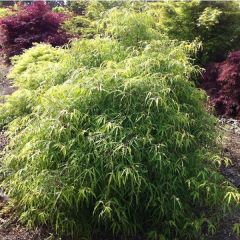
Fagus sylvatica Mercedes - Beech
- Flowering time May, June
- Height at maturity 2 m
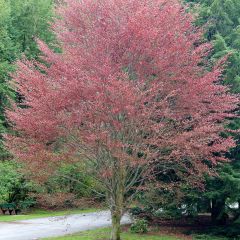
Fagus sylvatica Riversii - Beech
- Flowering time May, June
- Height at maturity 20 m

Fagus sylvatica Pendula
- Flowering time May, June
- Height at maturity 15 m
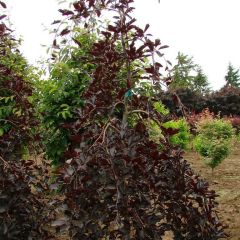
Fagus sylvatica Purpurea Pendula - Beech
- Flowering time May
- Height at maturity 4 m
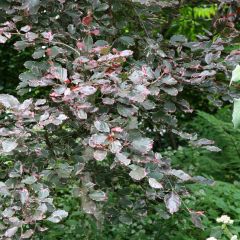
Fagus sylvatica Purpurea Tricolor - Beech
- Flowering time May, June
- Height at maturity 10 m
Discover other Fagus - Beech
View all →Available in 5 sizes
Available in 1 sizes
Available in 1 sizes
Available in 1 sizes
Available in 1 sizes
Available in 1 sizes
Available in 1 sizes
Available in 1 sizes
Available in 1 sizes
Available in 1 sizes
Beech planting
Where to plant?
Beech favours rich, cool but well-drained soil.
Normally, this tree prefers shade or partial shade, especially in drier climate and for golden-leaved or variegated varieties. But it can be tried in full sun under a wetter climate, notably with purple-leaved varieties. Avoid planting beech in Mediterranean regions, as hot, dry climate does not suit it.
please note: Bear in mind that, as a general rule, golden-yellow and variegated leaves should be planted in shade or partial shade, whereas purple or darker leaves perform better in sun.
Root system of this tree is surprisingly shallow, since it does not need deep rooting in closed forest. Take care not to damage roots if you plan to plant underneath (remember that few other plants will manage to grow under such dense foliage!), and also avoid planting beech in exposed, windy sites. Fallen beeches are often seen after severe storms. In nature, this creates light for other plants, supports fauna and xylophagous fungi that feed on dead wood and… it also creates a temporary natural pond where the tree was still rooted.
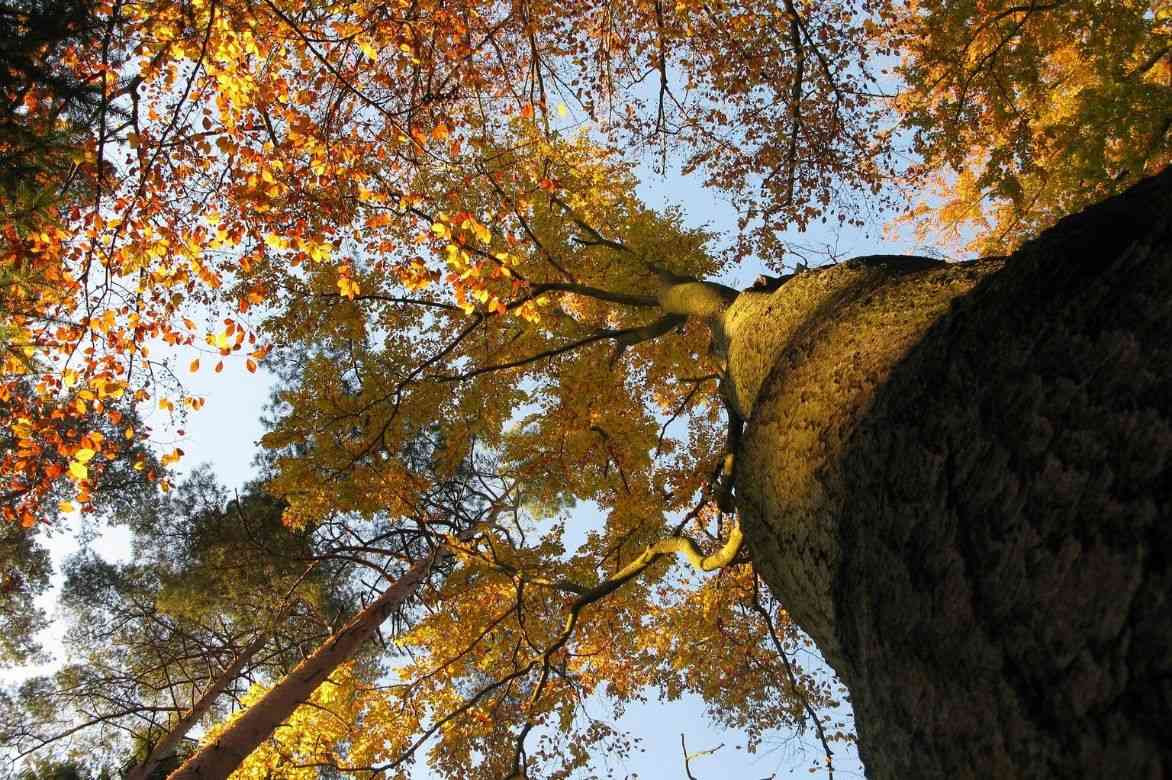
When to plant?
Best planted as bare roots, in buckets or even in containers during autumn: November to December. Establishment will be much better than in spring.
How to plant?
For a hedge
For economy and if not in a hurry, buy young beech plants as bare roots or in buckets. For a low hedge (under 1 m tall): space young plants 0.50 m apart. For a taller hedge: space plants 0.80 m apart. Planting in two staggered rows will produce a much denser hedge.
To plant a beech hedge :
- Start by digging a trench 50 cm deep and keep excavated soil to one side.
- Loosen soil and, if necessary, add some well-rotted compost to improve drainage and structure.
- As with all hedges, remember to add a few shovelfuls of well-rotted manure into the trench to give young trees a good start.
- Place trees taking spacing (see above) and layout into account
- Backfill trench with previously excavated soil.
- Firm soil around tree bases by hand
- Water well at base of each plant to limit risk of air pockets between roots and soil.
As a specimen or in a small group
- Container planting is preferred to save time, and because compact and most ornamental varieties are generally not available in buckets or as bare roots.
- Dip pot in a bucket of water for a few minutes to rewet rootball
- Dig a hole twice the volume of the rootball
- Keep excavated soil to one side, on a tarp to avoid damaging short grass meadow or other plants
- Loosen rootball slightly to spread roots
- Add a few handfuls of well-rotted compost to bottom of hole
- Place rootball in bottom of hole
- Backfill hole with excavated soil
- Firm soil around base by hand
- Give a good watering to reduce risk of air pockets forming between roots and soil
- Apply a mulch to protect young tree from drought
- Remember to stake your young beech
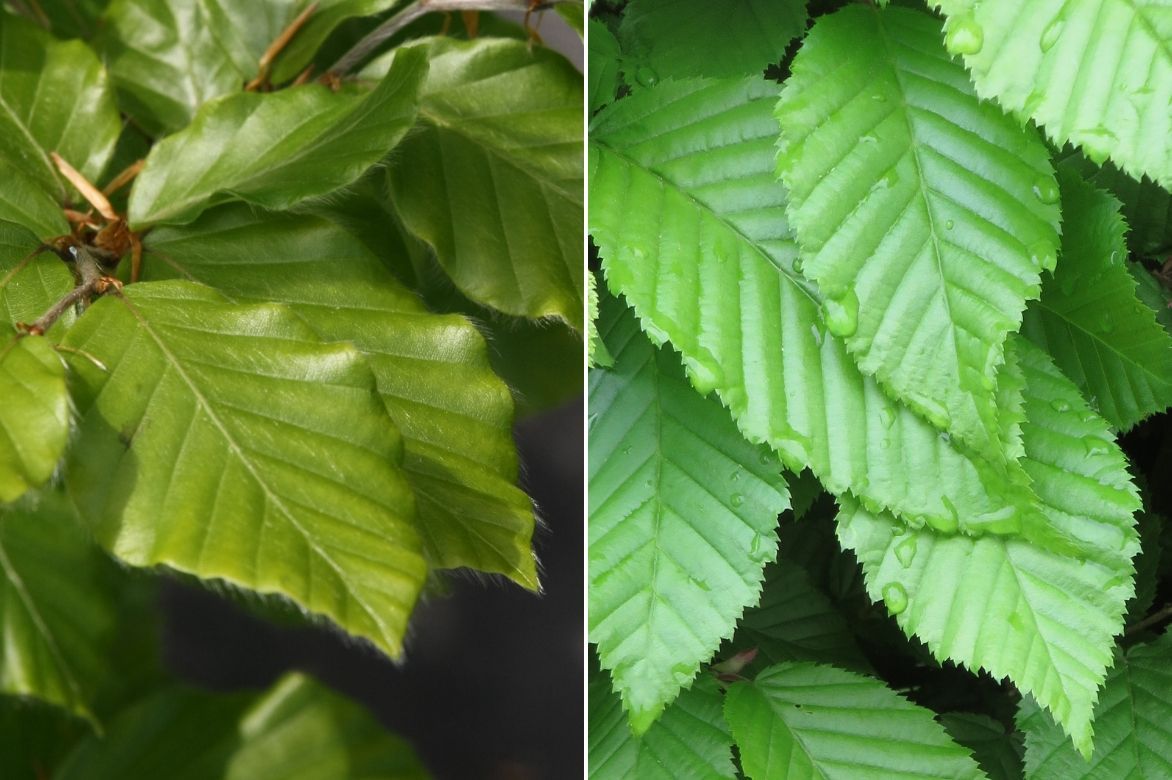
Comparison between villous leaves of beech (left) and dentate leaves of hornbeam (right)
Pruning, maintenance and care
Care
For an adult beech, care simply amounts to watching the tree grow! However, during first four years after planting a young specimen, remember to supply water during occasional droughts. Also keep a good mulch at the base to retain moisture.
Beech pruning
Beech is pruned from November to December or from February to the end of March. On a young tree, remove a few poorly positioned branches.
For hedge pruning, start with a cut towards end of June then complete with a second cut between August and September. Severe pruning can be carried out on a hedge long neglected or to rejuvenate it — beeches re-sprout well from the base.
please note : make sure to thoroughly disinfect cutting tools! Disease can spread very quickly in beeches…
Potential diseases and pests
In youth, this tree sometimes contracts fungal diseases and is attacked by a few insects associated with beech.
Insects
The wooly aphid (Pyllaphis fagi) attacks young shoots and underside of leaves on very young trees. Small cottony clusters can then be seen, leaves eventually dry out and fall before autumn. On mature trees there is no need for concern, but young beeches should be monitored. In case of infestation, spray black soap on aphids or remove them by hand.
Some scale insects, known as Cryptococcus fagi, attack the bark of trunk and large branches and can cause brown ooze as well as unsightly white patches. This attack is not immediately dangerous for tree except that it favours development of fungus Nectria coccinea which can cause tree decline.
The beech leafhopper or Typhlocyba Cruenta attacks young trees grown from sowing. Leaves then take on a lead-grey appearance before falling off completely.
Beech is also one of host plants of Gypsy moth caterpillar or Lymantria dispar. It feeds on leaves before transforming into a moth. In cases of major invasion this moth can be problematic; a commercially available Bacillus thuringiensis product can help stop an outbreak.
Last insect associated with beech, the beech weevil or Orchestes fagi favours the tree’s leaves. Mature trees usually tolerate this without much harm, unfortunately not always the case for very young trees. Best way to stop an attack is to collect and relocate the insects.
please note : a wildlife-rich garden where many animals thrive will help reduce number and impact of beech “pests” (and pests of other plants too). Bear this in mind!
Fungal diseases
The canker of beech caused by Neonectria ditissima deforms trunk and branches with cankers that eventually dry out. Young trees may die. Only control is to remove and burn affected branches.
Ink disease caused by Phytophthora cambivora or Phytophthora cinnamomi attacks beech roots, which then turn black. Flame-shaped patches may be visible at base of trunk. No effective treatment exists. Above all, plant in well-drained soil to reduce risk.
Honey-coloured honey fungus or Armillaria Mellea, infamous, is a basidiomycete fungus that first attacks roots and progresses into tree over years. When sporophores (visible “mushrooms”) appear at base, it is already too late — tree is dying.
Because of its natural habitat — humid, poorly ventilated woodland — beech can also suffer from powdery mildew. A whitish, powdery coating covers entire young tree. If your beech is not overcrowded by nearby plants and moisture is not stagnant, there is no reason it should contract powdery mildew.
→ Find out more about plant gall, which can affect beech
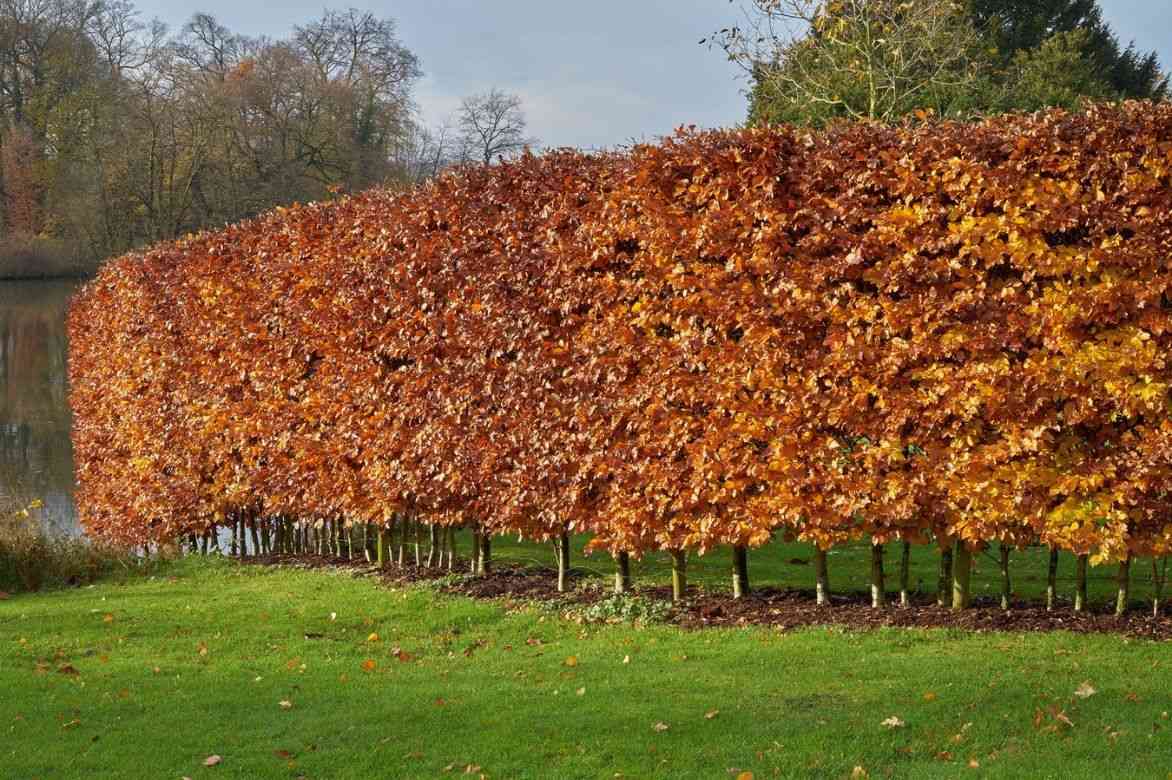
Beech hedge with marcescent foliage
Propagation
By sowing
Sowing seeds of typical species is done in autumn or early winter, in open ground or under a cold frame, in a substrate half potting compost, half river sand, kept moist but not waterlogged. Germination occurs the following spring.
You can mimic nature by keeping seeds in a refrigerator all winter. Then sow seeds in spring under a cold frame. Shoots appear a few weeks later.
By propagation by cuttings and by layering
Propagation by cuttings is practically impossible. Layering is theoretically feasible but remains complicated.
By grafting
To multiply varieties, grafts can be made onto a seed‑grown common beech rootstock. Scion will be a young shoot of the year. Either a whip graft or a shield budding can be used.
- Whip graft, June to August: cut rootstock on a slant and bring together a shoot of roughly the same diameter from variety to be reproduced, cut on the same angle so it matches the rootstock cut. Secure everything firmly with raffia. Graft takes when scion begins to produce leaves.
- Shield budding: make a “T” incision in a section of rootstock bark and lift this bark slightly. Insert a “shield”, that is an eye taken from variety to be reproduced. This eye is taken using a razor blade or very sharp knife. Fix everything with raffia or clothes pegs. Graft takes when scion begins to produce leaves.
Companion planting with beech
In a copse
Even if a common beech can quickly become cumbersome, it is still worth trying a striking purple beech and pairing it with bushes with colourful foliage that will contrast with the purple leaves. In addition, those bushes will benefit from the shade provided by the beech. Simple but always effective, Cornus alba ‘Gouchaultii’ will bring a touch of cheer and contrast in the beech’s shade with its foliage variegated with yellow, while creating a link thanks to the almost black-purple twigs visible in winter. A less subtle echo could come from Cercis canadensis ‘Forest Pansy’ with purple foliage and spectacular flowering from early spring. A rosemary willow (yes, it exists!) is a lovely sun-loving option to add a silvery touch near the beech. Complete the picture with a carpet of Anemone nemorosa ‘Lychette’ and bluebells to brighten the base of the beech in spring before it flowers. A Climbing hydrangea ‘Silver Lining’ used as groundcover and climber will be an excellent way to lighten the tree’s shade and its branches.

An example of a copse planting: Fagus sylvatica ‘Atropurpurea’, Cornus alba ‘Gouchaultii’, Cercis canadensis ‘Forest Pansy’, Anemone nemorosa ‘Lychette’, Salix rosmarinifolia and Scilla nutans
In a two-colour hedge
Why not try alternating green and purple by planting beech of different colours? It is an idea still rather uncommon in gardens, yet it produces an attractive result while adding dynamism to a formal hedge. To do this, plant in two rows: 2 + 2 purple beeches, then immediately beside them 2 + 2 green beeches, and so on. For a narrower hedge, you can plant in a single row and alternate more frequently for a more… striped appearance.
Also…
Beech is also a splendid tree when grown as a specimen if given enough space to unfold in all its majesty. Of course, that is only feasible in very large gardens or parks for typical species. Remember, however, that many varieties and cultivars of much more compact size exist and can easily be adopted in almost any garden.
Beech is a good choice for trying bonsai because of its robustness, reduced root system and ability to tolerate repeated pruning without complaint. Just bear in mind that it dislikes heat and drought, which is even worse in a very small pot…
Did you know?
- Toxic fruits, if consumed in large quantities, have an almost abandoned culinary use; an edible oil was once extracted from them.
- They are, however, much appreciated by birds and many animals (rodents and others), which thus disperse them in the wild.
- Beech wood is a dense, hard wood with a fine grain. It is still used today in carpentry and cabinetmaking.
- Beech wood is also used to make paper or as firewood.
- Bark was used in medicine to combat malaria, but also as an anthelmintic, for certain respiratory conditions and as an antidiuretic.
Further reading...
- Find our selection of beech trees in our online nursery.
- We tell you everything to choose a beech for your garden.
- Find our advice to learn: how to choose a beech for your garden, how and when to prune beech, how to make a beech hedge
- Not convinced by beech? In that case, try hornbeam: Hornbeam, hornbeam hedge: planting, pruning and maintaining
- Ingrid explains how to make beech leaf tea?
- Beech-nut, an edible beech fruit to discover
- Subscribe!
- Contents
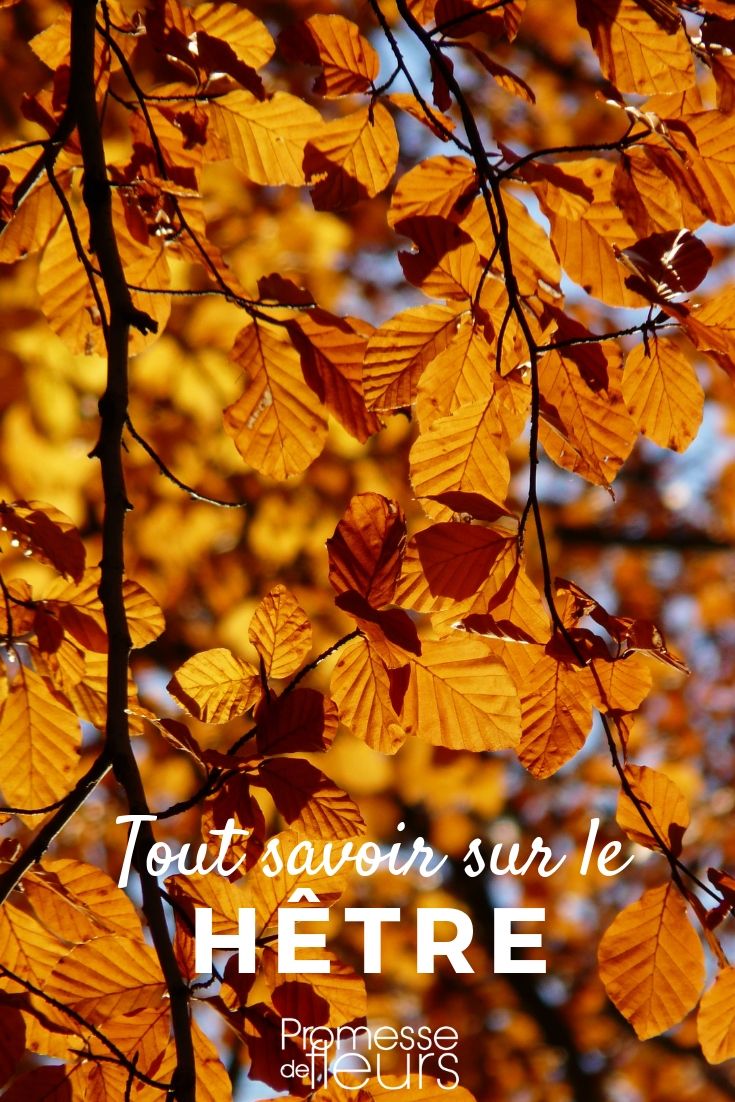

































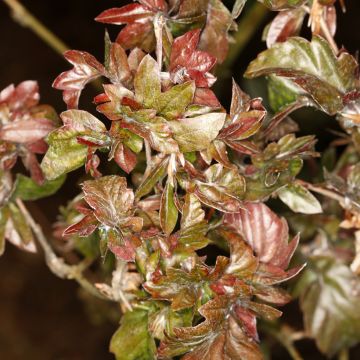

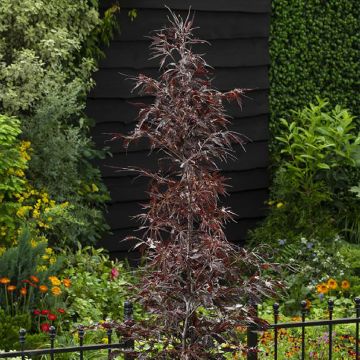

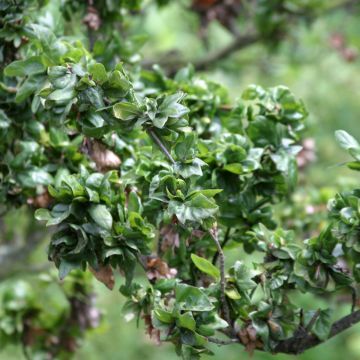

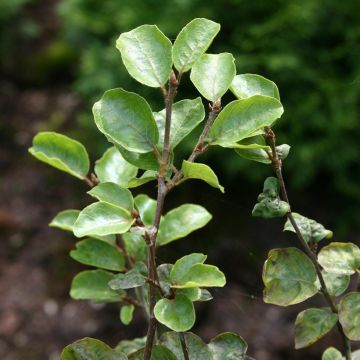
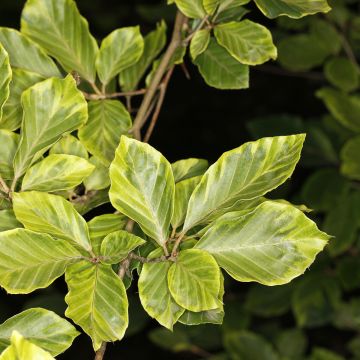
Comments